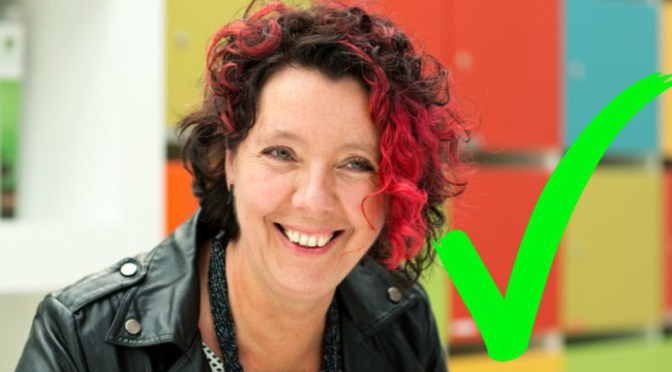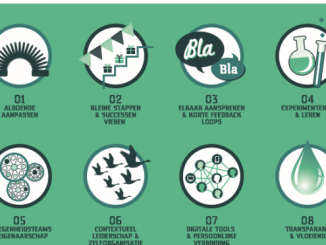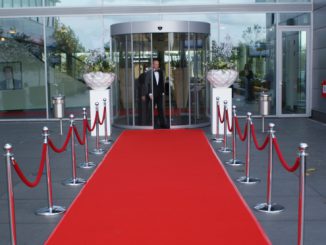
Blog van Corporate Rebels over zelfsturing bij Hollands Kroon. In gesprek met Anja van der Horst, mei 2016.
Successful self-management? Forget the rules and welcome failure!
Recently, we wrote about the amazing story of Frank van Massenhove and how he transformed the Belgian Federal Office of Social Affairs. We were surprised by the modern organization that was set up, especially because of the preconceptions we had regarding governmental organizations. Apparently, there is a good Dutch example as well: municipality Hollands Kroon. We went to visit them in Anna Paulowna, a city in the northern part of Holland. We met with Bucket List hero Anja van der Horst, driving force behind the new-style municipality and Director of Operations.
The young history of Hollands Kroon
‘Hollands Kroon’ is a municipality that was created in 2012 as a merger of 4 smaller municipalities. The municipality consists of 50.000 inhabitants and 360 civil servants. The newly born municipality used this fresh start to organize their organisation in such a way that it was best able to fulfill its purpose: allowing their inhabitants to be more entrepreneurial and self-reliant. Anja explained to us the story of how they envisioned their organization to be. And how the transformation process has been so far. Explore the 4 things that stood out the most in our conversation.
1. Top down rather than bottom up
The leadership of Hollands Kroon consists of three directors, of which Anja is one. All directors are convinced that a new type of leadership is needed for them to be able to create an organization that fits the 21st century. They want their inhabitants to be entrepreneurial. In order to do that the civil servants shouldn’t be asking permission for everything they do or want to do. There’s only one way to do this according to the leadership: the introduction of self-management. They design an organization consisting of two layers: one layer of leadership and one layer of about 40 self-managing teams (circa 9 employees each).
Different approaches
In all organizations we’ve been, the leaders (as can be expected) are the ones taking the first steps in the transformation process towards liberation. However, we witnessed two different paths towards this liberation process.
Top down
For some leaders self-management is a predetermined goal at the start of their leadership. They themselves are convinced about the advantages of this model and often implement it top down into the organization. The story about Hollands Kroon is a clear example, but we have seen it in other organizations as well (i.e. the story of Frank van Massenhove and Sjoerd van der Velden).
Bottom up
For other leaders self-management derives from the result of listening to the specific needs of the employees. The implementation of self-management can than be regarded as the result of a bottom up feedback process. This is contrary to the story about Hollands Kroon but we have witnessed this in other organizations (i.e. the story of Carin Wormsbecher and Kees Pater).
2. Result-based evaluation as a crucial step
In most organizations people work from 9 to 5. During the 8 hours they are in the office they are expected to do as much work as possible. Normally we are partly evaluated on the amount of time we spend in the office. Anja has let go of this partial time-based evaluation. Instead Hollands Kroon focuses solely on evaluations based on the achieved results and the produced output. The civil servants of Hollands Kroon set their own goals based on the overall targets of the municipality and will be evaluated based on their results and output.
We’ve seen the same at the Belgian Federal Office of Social Affairs; workers were not evaluated on time at all. The head of the department even admitted (proudly) that the average weekly hours made by each civil servant lies around 30-35 hours. He told us that he doesn’t care when, how or where people work, as long as they reach the goals that have been set.
3. Get rid of rules and welcome failure
Anja advocates that the easiest thing about the implementation of self-management is getting rid of the rules. She underlines her statement with a remarkable quote: “Organizing is quite simple. Just get rid of the rules“. The hardest part according Anja: welcoming failure. Anja: “Once you get rid of the rules and once you let employees decide how to work, mistakes will be made. The hardest part of self-management is not interfering when something goes wrong. If you interfere, it will never work“. She admits this is very hard for herself as well. She is constantly aware that she shouldn’t fall into the trap of telling people what to do when things go wrong. “If you don’t take distance, people will never take responsibility and self-management will surely fail.”
At Hollands Kroon the employees learned the basics of self-management in a 2-day training. After the training all employees were very enthusiastic about starting with the new ways of working. Their next assignment: write a plan with clear goals and results for your team. Anja starts laughing: “When the discussions and arguments start, the teams immediately get back to reality. They notice it’s not so easy to be a self-managing team. However, as long as you don’t interfere, the teams will surely figure it out themselves. These are valuable lessons in learning self-management.“
4. Department managers are unwilling to change
Most of the employees are enthusiastic about the self-management structure. However, some are less enthusiastic. Especially the managers are reluctant and would rather keep on working the way they’re used to. This seems understandable as their comfortable position is at risk. Once self-management is fully implemented, their job will probably disappear as their responsibilities will be distributed within the teams. All managers were offered new roles within the team. 7 out of 9 managers took the offer, 2 quit as they were unsatisfied with the redistribution of roles.
Just like at Hollands Kroon, we’ve seen in other transforming organizations that there are always some employees that do not want to be part of the new workplace. They quit their jobs to find places that better match their expectations of work. Some prefer working for a boss, some cannot handle the freedom and responsibility, or some, as with Hollands Kroon, want to keep their managerial positions.
The fact that some people leave these transforming organizations is an important aspect. It shows that there is not a one-size-fits-all solution for creating happy companies. Not all people are the same, and therefore not all organizations should be the same.
A governmental rebel
After our talk with Anja we got back in the car and evaluated the conversation. We loved Anja’s no-nonsense approach towards self-management. Her take-it-or-leave-it mentality seems to have been a powerful tool in breaking through old habits and transforming into a modern and future proof municipality.
Anja is a governmental rebel. Her rebelliousness showed in her approach, her eyes, her talk, and definitely in her results. The most impressive result is the fact that the transformation program is well ahead of schedule. Instead of completing the organizational transformation by 2018, the completion will be done by the end of this year. Definitely not something that holds for most organizational change programs.
Bron: klik hier



